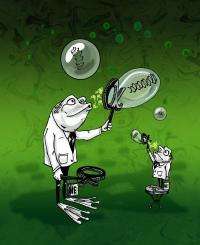Scientists find signals that make cell nucleus blow up like a balloon

Size matters when it comes to the nucleus of a cell, and now scientists have discovered the signals that control how big the nucleus gets.
Nuclear size varies not only among different species, but also in different types of cells in the same species and at different times during development. In addition, cancer cells are known to develop larger nuclei as they become more malignant. Screening for cervical cancer, for example, involves looking for grossly distorted nuclei in cervical cells collected during a Pap smear.
"Pathologists look at nuclear size in cancer cells for staging different cancers, but nobody knows what is behind this," said Rebecca Heald, professor of molecular and cell biology at the University of California, Berkeley.
As a result, she and post-doctoral fellow Daniel L. Levy explored why the nuclei of two species of African clawed frog are so different in size and discovered that the large nucleus of Xenopus laevis sucks in more material while growing than does the small nucleus of Xenopus tropicalis.
The two researchers tracked down the proteins streaming into the nucleus and discovered that they were importing structural material used to build the web of lamin proteins that shores up the inside of the nuclear shell. The faster the import of lamin and other structural proteins, the faster it is added to the underside of the nuclear envelope, inflating it like a balloon.
In addition, they found that another protein sits like a plug at the entrances to the nuclear envelope – the nuclear pore complexes – to slow the importation of large proteins. Together, these two different proteins – the importing protein, importin-alpha, and the gatekeeper, ntf2 – account for the difference in size between the nuclei of the two frogs.
"The different levels of these two factors is sufficient to account for our nuclear size differences," Levy said.
"There was a lot more importin-alpha and a lot less ntf2 in Xenopus laevis, and we found out that we can convert Xenopus tropicalis into laevis just by adding excess importin and partially getting rid of ntf2 in egg extracts," Heald said. "We thought this could be really complicated, but it isn't.
"Now that we understand some of the mechanisms that regulate nuclear size, we can try to decrease nuclear size in cancer cells ands ask, does the cancer cell care? Maybe it will and maybe it won't."
Levy and Heald report their findings in the Oct. 15 issue of the journal Cell.
Heald has long been interested in what regulates the size of a cell's internal structures – in particular, the nucleus and the spindles that pull chromosomes apart during cell division.
In certain amphibians, the larger the animal, the larger the genome and the larger the cells and nuclei. For mammals, however, that is not necessarily the case. Nevertheless, when mammalian cells become aneuploid – that is, they no longer have two copies of each chromosome – they often grow a larger nucleus. Aneuploidy is associated with cancer.
In 2006, Heald was awarded a five-year, $2.5 million Pioneer Award from the National Institutes of Health to pursue research on cell organelle size, work deemed too "risky" for regular NIH funding.
To explore these questions, she works in test tubes filled with the guts of hundreds of frog eggs. The guts consist of cell-free cytoplasm extracted from the cellular envelopes by centrifuging. By adding new proteins or antibodies that block existing proteins, she can explore the regulation of many activities inside the cell.
For these experiments, she and Levy extended the technique from X. laevis to the smaller X. tropicalis, whose eggs have about one-fifth the volume. Part of the size difference is due to the fact that X. laevis is tetraploid – it has four copies of nearly every chromosome – whereas X. tropicalis is diploid, with two copies of each chromosome. Working with extracts allowed the researchers to find importation proteins that differed in concentration between the two species and thereby track down the mechanism of nuclear inflation.
Specifically, X. laevis has three times more importin-alpha than does X. tropicalis, while tropicalis has four times more ntf2 than does laevis. By adjusting levels of these proteins in X. tropicalis egg extracts, they were able to make this species' nuclei balloon up to the size of X. laevis nuclei.
"We can now ask physiologically what happens when you change nuclear size," Heald said. "If you make the nucleus bigger, does it become more cancer-like? How related are these two phenomena, cancer and nuclear size, which are associated but with no real causal effect."
Heald and her colleagues are also tracking down the proteins that control the size of the spindles in X. laevis and X. tropicalis. Malfunctioning of spindles can lead to improper segregation of chromosomes during cell duplication, which results in aneuploidy and cancer.
Provided by University of California -- Berkeley
















